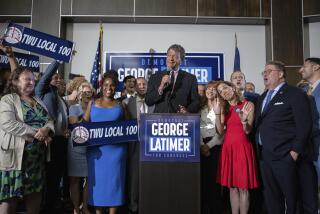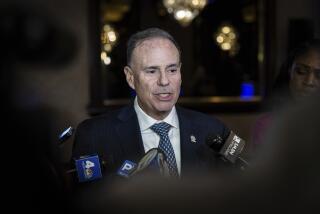Cuomo in Tight Race With Pataki : New York: Incumbent Democratic governor benefiting from third-party candidate’s strong showing in northern part of the state.
- Share via
NEW YORK — Befitting their bitter campaign, Gov. Mario M. Cuomo and his Republican opponent, state Sen. George Pataki, were locked in a tight race Tuesday that pitted voters in New York City against northern regions of the state.
Exit polls showed the governor running well with constituencies he diligently courted. Cuomo was receiving 90% of the black vote and scoring better among men than polls taken before the election had anticipated.
Independent candidate B. Thomas Golisano was cutting into Pataki’s vote, particularly upstate, where election officials said the turnout was heavy.
In New York City, election officials said the turnout was “moderate to heavy.”
A defining event of the bitterly contested election was the endorsement of Cuomo by New York City’s Republican mayor, Rudolph W. Giuliani, prompting Pataki to lash out that the mayor was a “back-stabber.”
At the same time, Pataki pledged he would work with Giuliani in an effort to blunt fears among city voters of a feud that could harm the city’s interests.
After Giuliani’s backing, which also earned the wrath of Sen. Alfonse M. D’Amato, the contest tightened in polls. “He (Giuliani) certainly gave him a big shove,” said a key Cuomo adviser.
President Clinton also appeared with Cuomo and called him a “national treasure.” A parade of Cabinet members visited the state to reinforce that message.
Cuomo’s advisers hoped for a heavy turnout in New York City and that Golisano’s candidacy would hold down Pataki’s upstate margins.
Those hopes received a boost last weekend when the 52-year-old Rochester, N.Y., businessman, who sought the governorship as the candidate of the Independence Fusion Party and who vowed to spend $10 million of his own funds on the contest, received the backing of Ross Perot, an independent presidential candidate in 1992.
Perot praised Golisano’s campaign as “electroshock therapy to the political system” and said Golisano’s third party would be a “tangible signal to Albany and Washington.”
Besides hoping Golisano would shock Pataki upstate, Cuomo and Giuliani mounted a large get-out-the-vote drive, especially in minority New York City neighborhoods. To win, the governor needed a strong turnout among blacks and Jews and other members of the city’s traditional Democratic coalition.
Election Day was a civic holiday, and state and city employees were enlisted on their own time in the vote-getting effort. New York City’s largest municipal union sent a letter to its 130,000 members urging them to reelect Cuomo. The union fielded 3,400 volunteers to help voters get to the polls. Volunteers manning phone banks made about 4 million calls on behalf of the governor in the closing days of the race.
The campaign was a brawl from the beginning. Cuomo’s commercials pictured Pataki as the untrustworthy captive of D’Amato, who engineered the GOP candidate’s nomination, helped him raise money and supplied key members of Pataki’s staff. The governor promised a high-tech future for New York State and pledged to “build a new New York where a productive job is available for everyone who wants to work.”
To the argument that he was in office too long, Cuomo quipped that he has been married to his wife, Matilda, for 40 years, and “if she starts thinking that way, I’m in big trouble . . . unless she had somebody better--if she had a bright young guy with a lot of money who could do the mambo.”
Pataki’s well-scripted campaign hammered home several themes in addition to the argument that a dozen years was enough and a vote for the Republican candidate was a vote for change and optimism.
With New Jersey’s Gov. Christine Todd Whitman at his side, the Republican candidate pledged he would cut state taxes by 25%. He also pressed his support for the death penalty, a mandatory cap on state spending, no parole for violent felons and term limits for elected officials.
More to Read
Sign up for Essential California
The most important California stories and recommendations in your inbox every morning.
You may occasionally receive promotional content from the Los Angeles Times.













